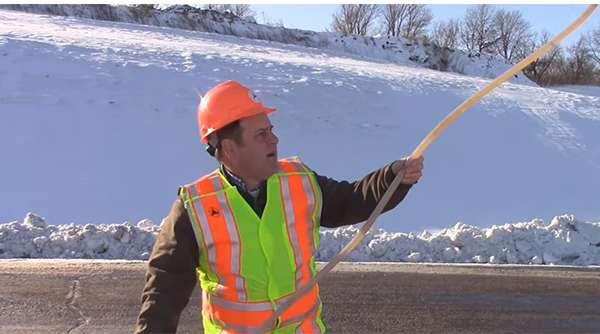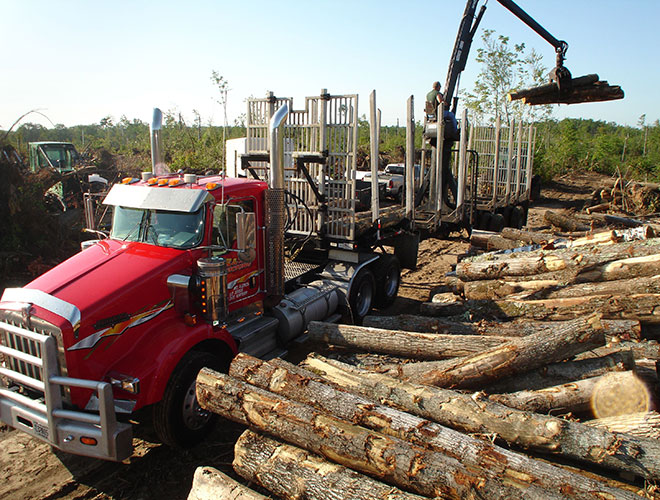Staff Reporter
Wisconsin’s Expanded Frozen Road Law Eases Weight Limit for Timber Haulers

The Wisconsin Department of Transportation has expanded its “frozen road” law that allows trucks moving forest products, salt and sand to carry heavier loads.
WisDOT announced Jan. 6 that this winter the frozen road law would apply to the entire state, not just the regions that are located in the northern half of Wisconsin.
The law takes effect every winter once the ground under highway pavement is frozen to a depth of at least 18 inches. When that occurs, the maximum gross weight for trucks with a minimum of five axles that are hauling logs, salt or sand is raised from 80,000 pounds to 98,000 pounds.
“The law’s provisions have been in place for many years and are primarily intended to assist timber producers that have a significant economic impact — especially in northern Wisconsin — move larger loads once roads and the subgrade below are sufficiently frozen to safely accommodate the heavier loads,” WisDOT spokesman Robert Miller said. “The extra weight is also allowed for the hauling of abrasives or salt for highway winter maintenance.”
The declaration applies to all numbered state and federal highways, but does not apply to interstates — except for portions of I-39 and I-41. It is usually in effect from December to late February or early March.
Under the law, heavier loads of peeled or unpeeled forest products cut crosswise (not including woodchips), and salt and sand for winter maintenance are allowed for a period of time determined by weather conditions.
“WisDOT and county highway personnel monitor temperature forecasts, along with frost tubes — liquid-filled devices under pavement — to help determine when roads are adequately frozen to accommodate heavier loads,” the agency said.
Timber companies work long hours when wintertime road laws are in effect to offset the times they cannot work during the spring thaw, which occurs from March through early May when the snow melts and weakens the pavement above it.

S&S Forestry Plus
Seasonal changes, and their effects on the roads, limit the amount of timber work that can be done in the spring, according to Henry Schienebeck, executive director of the Great Lakes Timber Professionals Association. Schienebeck, who worked as a self-employed trucker for 32 years prior to joining the timber association, said that companies build inventories in the winter until the ground stiffens.
“We know that when we get where it starts warming up and the snow starts melting, we’re not going to be harvesting wood in the forest at that time,” Schienebeck said.
He said timber professionals in the Great Lakes area typically move about 2.8 million cords of raw forest products a year. A cord is a stack of wood measuring 128 cubic feet. About 40% of the total product moved every year is cut in the winter months, Schienebeck said.

Kedzie
Neal Kedzie, president of the Wisconsin Motor Carriers Association, said the movement of forestry products and lumber is one of the primary industries in Wisconsin and the Upper Peninsula of Michigan. He said companies take advantage of the frozen road period because it does not force them to divide their loads.
“This is pretty much the industry that’s job-sustaining in that part of the country,” Kedzie said. “Because the winters are so long and stay so cold for such a period of time, that’s what that is all about. It does help to increase the amount of freight that’s being transported.”
According to Miller, some 3.7 million tons of forest material, valued at more than $550 million, moved across Wisconsin roadways in 2015.
Several other northern states also have seasonal restrictions on vehicle weight. Minnesota’s rules, similar to Wisconsin’s, allow for a 10% increase in weight for trucks during winter months. Michigan’s springtime restrictions force trucks to comply with a weight reduction of 25% of their total weight on concrete pavements and 35% on asphalt pavements during the thaw. Idaho mandates trucks and buses weighing 10,000 pounds or more be restricted to 30 miles per hour in “critical areas” during the spring.
Schienebeck said when he started in the timber industry he could afford to take two months off during the spring thaw and maintain his vehicle because insurance was not overly expensive. Now, some of his members pay up to $10,000 a month in insurance, a payment that is demanded regardless of season.
“In the winter time you work,” Schienebeck said. “You have to have a lot of production and you have to get a lot of wood piled up to be able to make it for two months without any checks coming in.”


